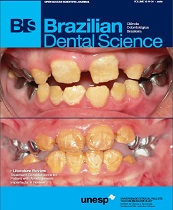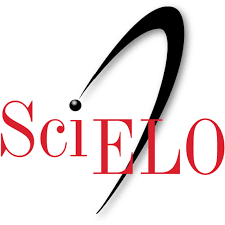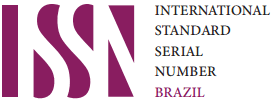Histological and microhardness evaluation of early artificial carious lesions in human and bovine enamel: in vitro study
DOI:
https://doi.org/10.14295/bds.2013.v16i4.929Resumo
Objective: Early carious lesions in bovine and humanenamel developed in vitro using a pH cycling regimenwere compared. Material and Methods: Fifteencentral bovine incisors and fifteen recently extractedhuman third molars were randomly divided into twogroups: ten for the cross-sectional microhardness test(MT) and five for polarized light microscopy (PLM)analysis. Enamel blocks measuring 5 x 5 mm weremade from the buccal face of the teeth. The blocksused for the MT were sliced into two halves: “A” and“B”. “A” slices were embedded in acrylic resin, withthe face of the dentin-enamel junction left exposedfor the MT prior to pH cycling. “B” slices and wholeblocks were coated with acid-resistant varnish,except a 3 x 3 mm central window, and submitted tothe pH cycling regimen (demineralizing solution for3 h and remineralizing solution for 21 h) over fiveconsecutive days. The “B” slices were then submittedto the MT and the whole blocks were processed forthe PLM study. Results: The PLM analysis revealedshallow, extensive lesions in the bovine enamel,hardly showing the superficial, dark and translucentzones, as well as deep cavity lesions in the humanenamel, with the body of the lesion and the darkzone evident. The MT revealed a significant decreasein microhardness in the superficial levels of thebovine enamel caries and at all depth levels of thehuman enamel caries. Conclusion: The pH cyclingregimen adopted led to the development of deeperand more demineralized carious lesions in humanenamel than bovine enamel
Keywords
Dental caries; Dental enamel; Microhardness tests; Polarization microscopy.
Downloads
Downloads
Arquivos adicionais
Publicado
Como Citar
Edição
Seção
Licença
TRANSFERÊNCIA DE DIREITOS AUTORAIS E DECLARAÇÃO DE RESPONSABILIDADE
Toda a propriedade de direitos autorais do artigo "____________________________________________________________________" é transferido do autor(es) para a CIÊNCIA ODONTOLÓGICA BRASILEIRA, no caso do trabalho ser publicado. O artigo não foi publicado em outro lugar e não foi submetido simultaneamente para publicação em outra revista.
Vimos por meio deste, atestar que trabalho é original e não apresenta dados manipulados, fraude ou plágio. Fizemos contribuição científica significativa para o estudo e estamos cientes dos dados apresentados e de acordo com a versão final do artigo. Assumimos total responsabilidade pelos aspectos éticos do estudo.
Este texto deve ser impresso e assinado por todos os autores. A versão digitalizada deverá ser apresentada como arquivo suplementar durante o processo de submissão.




























